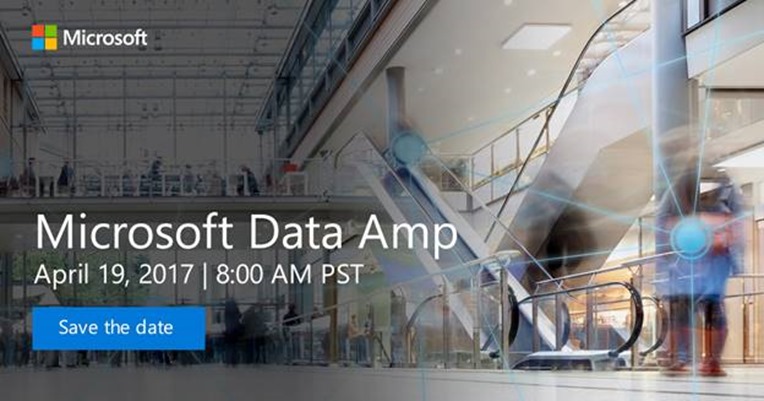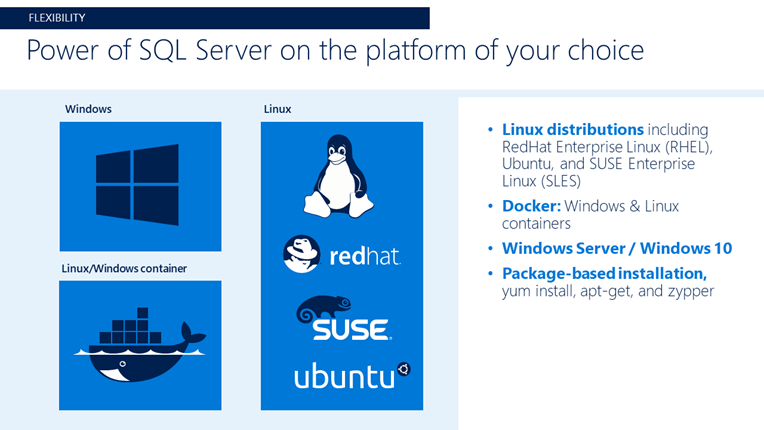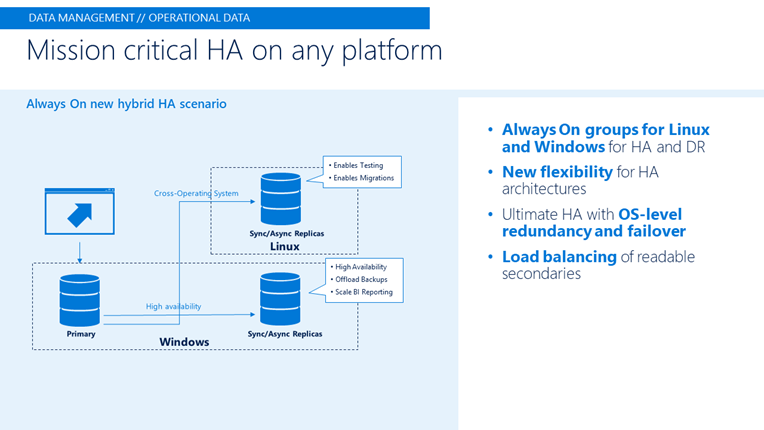Top three capabilities to get excited about in the next version of SQL Server

We announced the first public preview of SQL Server v.Next in November 2016, and since then we’ve had lots of customer interest, but a few key scenarios are generating the most discussion.
If you’d like to learn more about SQL Server v.Next on Linux and Windows, please join us for the upcoming Microsoft Data Amp online event on April 19 at 8 AM Pacific. It will showcase how data is the nexus between application innovation and intelligence—how data and analytics powered by the most trusted and intelligent cloud can help companies differentiate and out-innovate their competition.
In this blog, we discuss three top things that customers are excited to do with the next version of SQL Server.
1. Scenario 1: Give applications the power of SQL Server on the platform of your choice
With the upcoming availability of SQL Server v.Next on Linux, Windows, and Docker, customers will have the added flexibility to build and deploy more of their applications on SQL Server. In addition to Windows Server and Windows 10, SQL Server v.Next supports Red Hat Enterprise Linux (RHEL), Ubuntu, and SUSE Linux Enterprise Server (SLES). SQL Server v.Next also runs on Linux and Windows Docker containers opening up even more possibilities to run on public and private cloud application platforms like Kubernetes, OpenShift, Docker Swarm, Mesosphere DC/OS, Azure Stack, and Open Stack. Customers will be able to continue to leverage existing tools, talents, and resources for more of their applications.
Some of the things customers are planning for SQL Server v.Next on Windows, Linux, and Docker include migrating existing applications from other databases on Linux to SQL Server; implementing new DevOps processes using Docker containers; developing locally on the dev machine of choice, including Windows, Linux, and macOS; and building new applications on SQL Server that can run anywhere—on Windows, Linux, or Docker containers, on-premises, and in the cloud.
2. Scenario 2: Faster performance with minimal effort
SQL Server v.Next further expands the use cases supported by SQL Server’s in-memory capabilities, In-Memory OLTP and In-Memory ColumnStore. These capabilities can be combined on a single table delivering the best Hybrid Transactional and Analytical Processing (HTAP) performance available in any database system. Both in-memory capabilities can yield performance improvements of more than 30x, enabling the possibility to perform analytics in real time on operational data.
In v.Next natively compiled stored procedures (In-memory OLTP) now support JSON data as well as new query capabilities. For the column store both building and rebuilding a nonclustered column store can now be done online. Another critical addition to the column store is support for LOBs (Large Objects).
With these additions, the parts of an application that can benefit from the extreme performance of SQL Server’s in-memory capabilities have been greatly expanded! We also introduced a new set of features that learn and adapt from an application’s query patterns over time without requiring actions from your DBA.
3. Scenario 3: Scale out your analytics
In preparation for the release of SQL Server v.Next, we are enabling the same High Availability (HA) and Disaster Recovery (DR) solutions on all platforms supported by SQL Server, including Windows and Linux. Always On Availability Groups is SQL Server’s flagship solution for HA and DR. Microsoft has released a preview of Always On Availability Groups for Linux in SQL Server v.Next Community Technology Preview (CTP) 1.3.
SQL Server Always On availability groups can have up to eight readable secondary replicas. Each of these secondary replicas can have their own replicas as well. When daisy chained together, these readable replicas can create massive scale-out for analytics workloads. This scale-out scenario enables you to replicate around the globe, keeping read replicas close to your Business Analytics users. It’s of particularly big interest to users with large data warehouse implementations. And, it’s also easy to set up.
In fact, you can now create availability groups that span Windows and Linux nodes, and scale out your analytics workloads across multiple operating systems.
In addition, a cross-platform availability group can be used to migrate a database from SQL Server on Windows to Linux or vice versa with minimal downtime. You can learn more about SQL Server HA and DR on Linux by reading the blog SQL Server on Linux: Mission-critical HADR with Always On Availability Groups.
To find out more, you can watch our SQL Server on Linux webcast. Find instructions for acquiring and installing SQL Server v.Next on the operating system of your choice at www.microsoft.com/sqlserveronlinux. To get your SQL Server app on Linux faster, you can nominate your app for the SQL Server on Linux Early Adopter Program, or EAP.
To find out more about SQL Server v.Next and get all the latest announcements, register now to attend Microsoft Data Amp—where data gets to work.




